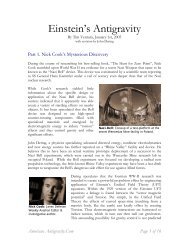A world of connections - Signal Lake Venture Fund
A world of connections - Signal Lake Venture Fund
A world of connections - Signal Lake Venture Fund
You also want an ePaper? Increase the reach of your titles
YUMPU automatically turns print PDFs into web optimized ePapers that Google loves.
production began in 2006. In the fourth quarter <strong>of</strong> last year alone the firm shipped<br />
10m <strong>of</strong> these chips. The chips have dropped from $50 apiece to around $5, and a<br />
phone that would have cost $250 five years ago is now $25. But rather than become<br />
even cheaper, in future the chips will <strong>of</strong>fer more features, says Greg Delagi, who<br />
heads TI's wireless unit.<br />
Engineers have been able to apply such<br />
innovations and economies <strong>of</strong> scale to other<br />
wireless technologies. As a result, some radio<br />
chips—for example, those used for the Global<br />
Positioning System, say, or for Bluetooth wireless<br />
communications—now cost as little as $1 and are<br />
the size <strong>of</strong> a matchhead. Chips with a newer<br />
technology called Zigbee, used for short-range<br />
sensors, which currently cost around $4 and are<br />
the size <strong>of</strong> a fingernail, are expected to shrink<br />
down to a quarter <strong>of</strong> the price and size in five<br />
years. A far simpler kind <strong>of</strong> chip called a radi<strong>of</strong>requency<br />
identification (RFID) tag, which sends a<br />
tiny quantity <strong>of</strong> data over a short range when<br />
activated, can already be manufactured for 4 cents<br />
apiece. Hitachi has a prototype chip that fits into<br />
the groove <strong>of</strong> a thumb-print. Last year 1 billion<br />
RFID chips were sold; this year the number may<br />
rise to 1.7 billion, according to IDTechEx, a<br />
consultancy.<br />
Belle Mellor<br />
All this means that many formerly self-contained<br />
things have become capable <strong>of</strong> communicating. For<br />
example, most big logistics companies in America<br />
and Europe now track their fleets with a combination <strong>of</strong> satellites and mobile-phone<br />
networks. Small wireless sensors monitoring equipment in large factories can provide<br />
early warning <strong>of</strong> impending breakdown. They can run on energy “harvested” from<br />
the heat or vibrations <strong>of</strong> the machinery.<br />
Let device talk unto device<br />
Apple's iPod and Nike's running shoes can interconnect so that the music player can<br />
select songs that match the jogger's pace. Large organisations such as retailers,<br />
hospitals and the armed forces are using RFID tags for managing stock levels. More<br />
robust versions <strong>of</strong> the technology are deployed in “contactless” bank cards,<br />
passports and public-transport passes.<br />
Yet this is only the start. And although many <strong>of</strong> the initial technologies were<br />
championed by America's defence industry—which gave life to the internet in the<br />
1970s—the most interesting applications are emerging in the private sector (again,<br />
as with the internet). Regulators are helping things along. Both Europe and America<br />
are considering proposals for fitting all cars with equipment that will automatically<br />
call the emergency services in the event <strong>of</strong> an accident. Some countries now require<br />
utility companies to read meters more regularly to promote energy conservation,<br />
giving a boost to wireless <strong>connections</strong>. Makers <strong>of</strong> medical devices are <strong>of</strong>fering more





